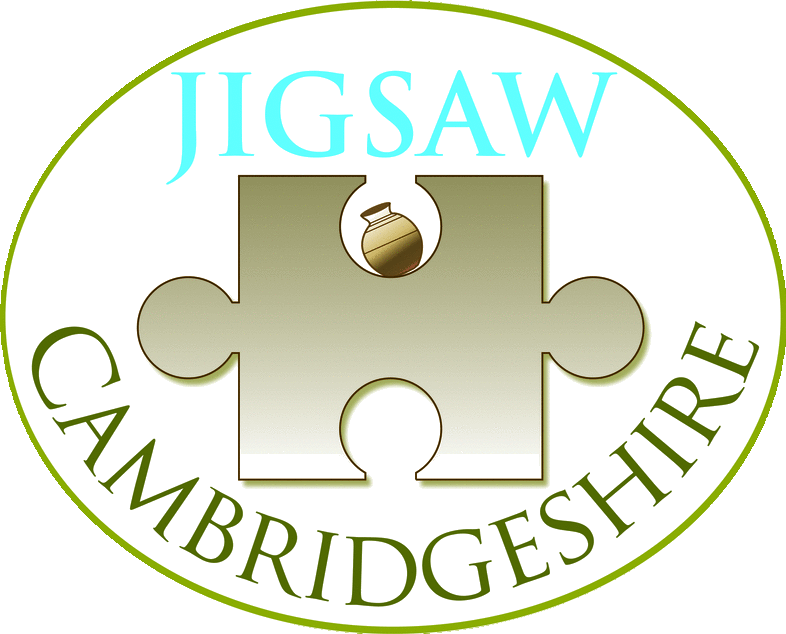Later Neolithic/Early Bronze Age Pottery 3200-1800 BC
In the period which spans the end of the Neolithic to the beginning of the Bronze Age two types of pottery were commonly in use in East Anglia. The first is Grooved Ware, named for the distinctive decoration of incised channels or lines which often covers its exterior surfaces. In older literature this type of pottery is sometimes called Rinyo-Clacton Ware, a name which reflects it widespread distribution from Scotland to southern England. In East Anglia
Grooved Ware is most commonly found in pits, sometimes deliberately placed in carefully arranged deposits, for example stacked in piles or as a lining around the pit base.
Grooved Ware pots are often made with grog-tempered fabric, meaning that it contains crushed pieces of pottery which was added to the clay by the potter. The addition of grog helps when forming the pots and improves thermal resistance and resilience meaning that it does not shatter so easily when being used for cooking. In Cambridgeshire shell-tempered Grooved Ware is also found. The vessels have flat bases and are tub or barrel shaped.
Three sub-styles of Grooved Ware have been identified in southern Britain and are widely referred to the literature, however the chronological succession and tight geographical distributions initially identified for each sub-style have been shown to be less certain now that many more examples of each type have been found and radiocarbon dating has become more widespread.
Durrington Walls style Grooved Ware is named after a large Causewayed Enclosure site in Wiltshire. Pots of this sub-style are large, bucket and barrel forms decorated with horizontal or vertical cordons forming panels filled with elaborate designs of zig-zags or sometimes spirals. Clacton vessels are more plainly decorated with simple rims with grooves or applied wavy bands of clay running around the inside whilst the outside is decorated with incised lines and dots within incised chevrons or lozenges. Woodlands sub-style tub-shaped pots have bands of clay stuck on the exterior forming a lattice with knots at the intersections, perhaps imitating a net or basket.
Beaker pottery is also used in the later Neolithic early Bronze Age, being largely contemporary with Grooved Ware but perhaps coming in a little later. Beaker was a new style of pottery introduced from Europe and was used for cooking and storage and as part of funerary rites. Like Grooved Ware, Beaker pottery is often grog-tempered but can be made of sandy fabrics or, occasionally shell-tempered fabric.
Beakers are highly decorated vessels often with curvy S profile bodies. Decoration can be incised, tool impressed or fingertip-impressed. Coarse fingertip-impressed decoration (also known as rustication) comprises pinched or jabbed fingernail or fingertip patterns covering the body of the vessel. These more robust Beakers with rusticated decoration are most often found on domestic sites. Beakers decorated with tool impressions, carried out with a bone or wooden comb, seashell, stick or twisted cord, tend to be finer and are found both in occupation and in funerary contexts often accompanying inhumation burials such as the Amesbury Archer. Beaker was in use from around 2500-1800BC.
Food Vessels were so named by the antiquarians who first studied them because they believed these robust vessels were used for food preparation in contrast to the more finely made drinking vessels or Beakers. In fact both types of pottery were used for a range of household and funerary purposes, though domestic deposits of Food Vessel are rare. In East Anglia Food Vessels are less common than in northern Britain being found occasionally as grave goods accompanying inhumations in barrows or as containers for cremations. Food Vessels are made of chunky fabric often with large grog inclusions.
Two shapes of Food Vessel are recognised, a dumpy ovoid ‘bowl’ and a taller ‘vase’ form. Both have rims with wide rim tops sometimes sloping to form an internal bevel which is decorated, frequently with cord impressions. Whist bowls have simple, rounded bodies, vase forms curve inwards below the rim to a deep concave neck or ‘cavetto zone’ widening at the girth then tapering again to the base. The exterior of Food Vessels is decorated, most often with short cord impressions or ‘maggots’ formed from a piece of cord wrapped around a stick and pressed into the surface of the clay. Recent research has suggested that Food Vessels were in use from around 2200/2100 until c.1800 (Neil Wilkin pers. comm.).
Collared Urns are broadly contemporary with Food Vessels with dates for use spanning c.2200/2100 to c.1450 and had a similar function, being rarely found in settlement contexts and more commonly in burials and as cremation urns in barrows. Collared Urns are mostly grog-tempered and are named for the prominent rim which forms a wide band or collar around the top of the vessel. Because of this Collared Urns were formally known as Overhanging Rim Urns. Collared Urns are often large and thick-walled with decoration around the rim top and collar whilst the lower body is plain. The decoration is frequently formed of cord impressions either similar to those seen on Food Vessels or forming geometric designs such as filled panels or hurdles.



